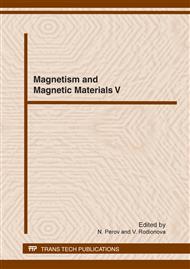p.522
p.526
p.530
p.534
p.538
p.545
p.550
p.554
p.558
Domain Structure Reversible Reconstruction and Changing of Domains Width in Ferrite-Garnet Films Caused by Water Molecules Adsorption
Abstract:
Due to water molecules adsorption the reversible change of domains width and domain structure reconstruction in bismuth-doped ferrite-garnet thin films with perpendicular magnetic anisotropy was observed. The change of domains width was 15% in saturated water vapor at room temperature. The decrease of domains width is explained by the reduction of effective perpendicular magnetic anisotropy constant due to water molecules adsorption.
Info:
Periodical:
Pages:
538-541
Citation:
Online since:
June 2012
Authors:
Keywords:
Price:
Сopyright:
© 2012 Trans Tech Publications Ltd. All Rights Reserved
Share:
Citation:


